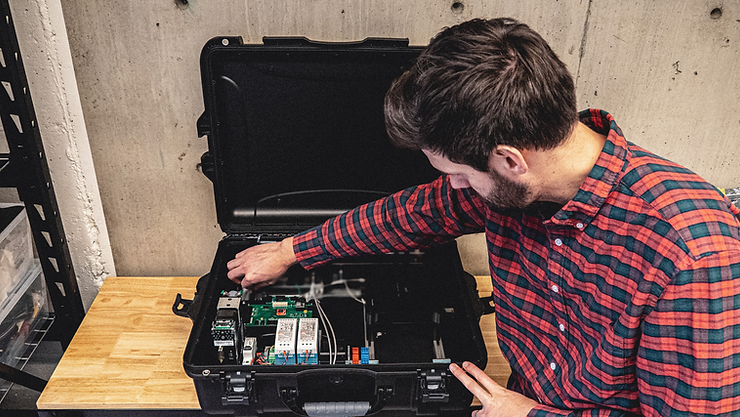Ocean Diagnostics successful in securing support to advance microplastic sensor
New in-situ technology will monitor microplastic pollution in aquatic environments

Ocean Diagnostics Inc. is pleased to announce it has successfully secured funding from the National Research Council of Canada Industrial Research Assistance Program (NRC IRAP) to advance to Phase 2 of the Innovative Solutions Canada (ISC) Plastics Challenge to develop industry-leading technology to detect and monitor aquatic microplastics in real-time. This easy-to-deploy microplastic sensor will fill the data gaps needed to understand how microplastics move through Canadian waterways and how they affect these ecosystems.
First to design this unit for a commercial market, Ocean Diagnostics Inc. created a sensor that detects the size and chemical composition of microplastics from the water column. This technology, developed and tested in Victoria, B.C., aims to automate the method of collecting and analysing microplastics in marine and freshwater environments. It allows for data collection in real-time, improves quality control, reduces contamination and is easily distributed with fewer risks and lower costs. Policymakers and organizations will be able to implement these sensors in coastal areas and streams to collect valuable data that can inform policy and reduce microplastic input into the environment.
“Our microplastics sensor greatly improves how microplastics are surveyed in the water column. It’s a device that’s critically needed to improve microplastic research and monitoring on a large scale,” says Ocean Diagnostics Inc. Co-Founder and Chief Technology Officer, Ethan Edson.
“Our microplastics sensor greatly improves how microplastics are surveyed in the water column. It’s a device that’s critically needed to improve microplastic research and monitoring on a large scale,” says Ocean Diagnostics Inc. Co-Founder and Chief Technology Officer, Ethan Edson.
Sponsored by the National Research Council of Canada (NRC), this ISC challenge is aimed at developing solutions to address some of Canada’s greatest challenges, including microplastic pollution in Canadian waterways. In May 2020, the NRC sponsored Phase 1 of the challenge calling all innovators to develop and test an on-site sensor that identifies and counts microplastics in water and in September 2022, Ocean Diagnostics Inc. was selected to move forward to Phase 2 of the program.
Microplastics are small pieces of plastic 5 mm or less in size that are either intentionally manufactured or fragmented from larger plastic litter. They potentially threaten the environment and human health. In addition to the millions of tons of plastic released into the marine environment each year, microplastics are accumulating in the environment and attracting public concern.
Microplastics have been found across the globe from remote arctic ice and deep sea beds to common beaches and rivers, but the abundance of microplastics and accumulation zones are unclear. Cities and organizations need technology to monitor how microplastics move throughout the environment to determine and prevent their sources.
Ocean Diagnostics Inc. has created a microplastic sensor that will reliably identify microplastic “hot spots” or accumulation zones, improve our understanding of microplastic exposure and risks to human health and the environment and help decision-makers know what areas and sources to target to prevent microplastic pollution.
“The applications for the sensor are quite diverse. Our goals are to place the sensor directly into any water system via a buoy, attach to remotely operated vehicles (ROV) or place on vessels of opportunity that regularly survey different water bodies,” notes Ethan.
“The applications for the sensor are quite diverse. Our goals are to place the sensor directly into any water system via a buoy, attach to remotely operated vehicles (ROV) or place on vessels of opportunity that regularly survey different water bodies,” notes Ethan.
Intelligently designed with convenience and quality control at the forefront, the sensor takes in water and instantaneously analyses microplastics present in the sample. Using a series of optical detection modules, the sensor records particle size and chemical composition to determine each type of particle flowing through the instrument. A report can be auto-generated from the data on the abundance and distribution of microplastics at the monitoring site.
The team’s success in ISC’s Phase 1 earned Ocean Diagnostics Inc. an additional two years of funding to develop a working prototype of the microplastic sensor and move it forward to commercialization.
Ethan expresses, “We see this technology being used by government organizations, environmental consultants, NGOs, academics and more. It offers the opportunity to create networks of coordinated monitoring sites to assess microplastic contamination in real-time and understand how our upstream policies and actions are influencing pollution levels downstream. It is an important step towards managing this pollutant for the betterment of our marine and freshwater environments.”
Ethan expresses, “We see this technology being used by government organizations, environmental consultants, NGOs, academics and more. It offers the opportunity to create networks of coordinated monitoring sites to assess microplastic contamination in real-time and understand how our upstream policies and actions are influencing pollution levels downstream. It is an important step towards managing this pollutant for the betterment of our marine and freshwater environments.”
Driven by environmental compassion, the team is eager to scale their unit.
Learn more about the microplastics sensor and other Ocean Diagnostics Inc. technologies here.
Ocean Diagnostics Inc. is an environmental impact company that tackles planetary threats of microplastic pollution and biodiversity loss through innovative technology, cutting-edge laboratory capabilities, collaborative partnerships and community science. Founded by scientists and engineers, we break the barriers of collecting and analyzing scientific data to influence informed decision-making.
